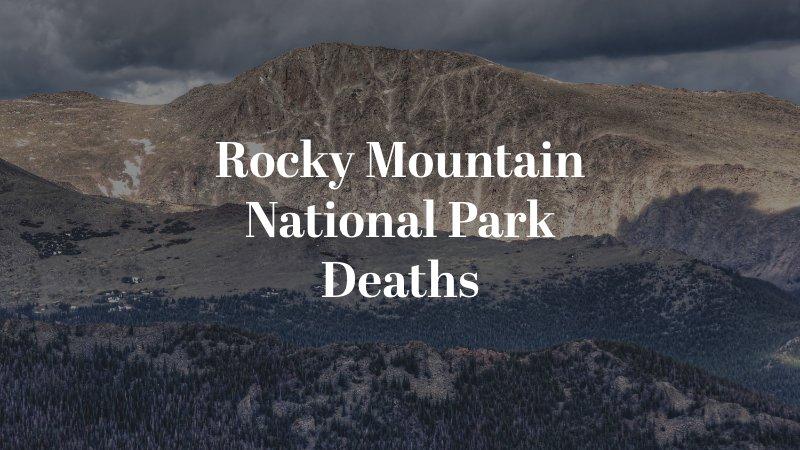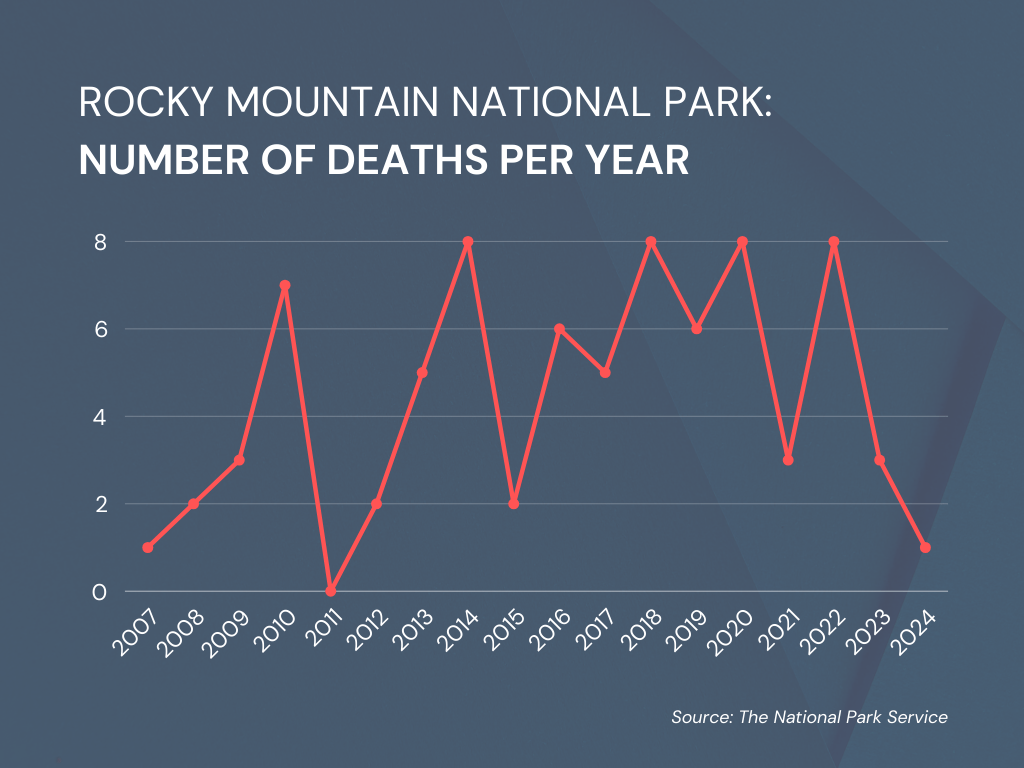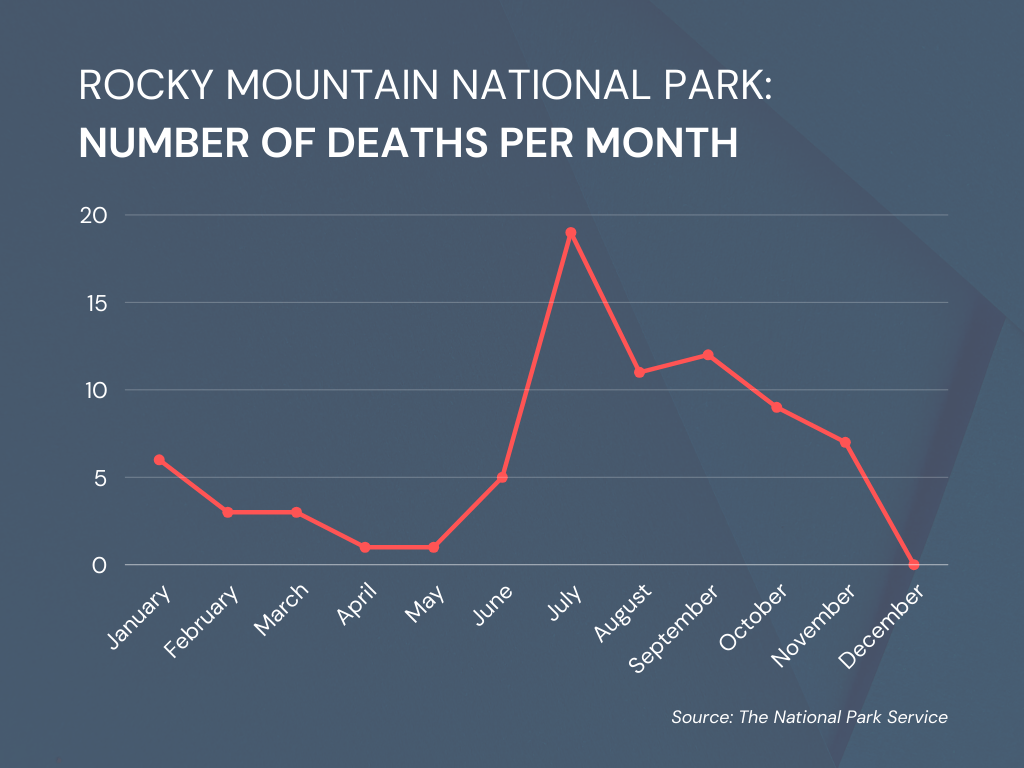Exploring the breathtaking beauty of Rocky Mountain National Park can be an unforgettable experience, but the park’s stunning landscapes also come with inherent risks. Unfortunately, accidents can happen, leading to serious injuries and, in some tragic cases, fatalities. Understanding the statistics surrounding deaths in Rocky Mountain National Park is essential for visitors and residents alike, as it sheds light on the potential dangers that can arise in this outdoor paradise.
This page will examine the key death statistics within the park, highlight common causes of these incidents, and discuss the importance of safety measures to ensure a memorable and safe visit.

Click on a link below to jump to that section on the page:
- How Many Deaths Have Occurred?
- How Many Deaths Happen Per Year?
- Causes of Death
- When Do These Incidents Occur?
- Demographics
- Safety Tips
How Many Deaths Have Occurred at Rocky Mountain National Park?
There have been 78 deaths at Rocky Mountain National Park from 2007 through 2024.
How Many Deaths Happen at Rocky Mountain National Park Per Year?
Among the 78 fatalities recorded since 2007 in Rocky Mountain National Park, some years have seen as many as eight deaths, while others have experienced none at all. The average is 4 per year.
Below is a breakdown of the yearly statistics, showing how the number of deaths has changed over the years to help visitors better understand the risks while enjoying the park.

| Year | Number of Deaths |
|---|---|
| 2007 | 1 |
| 2008 | 2 |
| 2009 | 3 |
| 2010 | 7 |
| 2011 | 0 |
| 2012 | 2 |
| 2013 | 5 |
| 2014 | 8 |
| 2015 | 2 |
| 2016 | 6 |
| 2017 | 5 |
| 2018 | 8 |
| 2019 | 6 |
| 2020 | 8 |
| 2021 | 3 |
| 2022 | 8 |
| 2023 | 3 |
| 2024 | 1 |
Causes of Death at Rocky Mountain National Park
Understanding the causes of death in Rocky Mountain National Park is crucial for anyone planning a visit. While the park offers breathtaking views and exciting activities, certain risks can lead to tragic outcomes.
The most common cause of death at Rocky Mountain National Park is falling while hiking.
| Cause of Death | Number of Incidents |
|---|---|
| Fall (Hiking) | 15 |
| Suicide | 13 |
| Medical Emergency (During Physical Activity) | 9 |
| Fall (Climbing) | 8 |
| Medical Emergency (Not During Physical Activity) | 7 |
| Undetermined | 7 |
| Fall (Activity Not Reported) | 5 |
| Hypothermia | 5 |
| Lightning Strike | 2 |
| Asphyxiation | 1 |
| Avalanche | 1 |
| Drowning | 1 |
| Fall (Skiing) | 1 |
| Homicide | 1 |
| Carbon Monoxide Poisoning | 1 |
| Skiing Incident | 1 |
When Do These Incidents Occur?
Below is a chart showing which months have the most fatalities at Rocky Mountain National Park. The majority of incidents occur in July and the fall months.

Demographics
The following breakdown shows the gender (sex) and age distribution of fatal incidents at Rocky Mountain National Park.
Gender Breakdown
Men account for 79% of all fatal incidents.
| Gender | Number of Deaths |
|---|---|
| Male | 62 |
| Female | 15 |
| Not Reported | 1 |
Age Breakdown
The highest number of fatalities has occurred among individuals aged 25 to 34 and those aged 65 and older.
| Age Range | Number of Deaths |
|---|---|
| 0-14 | 1 |
| 15-24 | 5 |
| 25-34 | 7 |
| 35-44 | 3 |
| 45-54 | 4 |
| 55-64 | 3 |
| 65+ | 7 |
| Not Reported | 1 |
Safety Tips For Exploring Colorado National Parks
Exploring the breathtaking national parks of Colorado offers a chance to connect with nature and experience stunning landscapes. However, outdoor adventures can also come with risks. To ensure a safe and enjoyable visit, consider these essential safety tips, organized into key categories, that will help you navigate the challenges of hiking, climbing, skiing, and more in Colorado’s beautiful wilderness.
Preparation and Planning
- Check Weather Conditions: Always check the forecast before heading out, as mountain weather can change rapidly.
- Know Your Limits: Choose activities that match your skill level and physical condition, starting with easier trails or routes.
- Inform Someone of Your Plans: Share your itinerary with a friend or family member, including where you’re going and when you plan to return.
Navigation and Gear
- Use a Map and Compass: Carry a physical map and compass as backups to GPS devices, which may fail in remote areas.
- Wear Appropriate Gear: Dress in layers and wear sturdy footwear. Ensure you have the right equipment for activities like skiing or climbing.
Hydration and Nutrition
- Stay Hydrated: Drink plenty of water, especially at high altitudes. Carry extra water on long hikes or climbs.
- Take Breaks and Listen to Your Body: Rest when needed and don’t push yourself too hard. Turn back if you’re feeling fatigued or unwell.
Wildlife Awareness
- Be Aware of Wildlife: Keep a safe distance from animals and never feed them. Stay alert for wildlife such as bears and mountain lions.
Safety Equipment and First Aid
- Carry a First Aid Kit: Bring a basic first aid kit for treating minor injuries, including band-aids and antiseptic wipes.
- Understand Avalanche Risks: If skiing or snowboarding in backcountry areas, know avalanche safety protocols and carry necessary gear.
Trail Etiquette and Regulations
- Follow Trail Markings: Stay on designated trails to prevent accidents and minimize environmental impact.
- Plan for Cell Service Limitations: Be aware that cell phone service may be limited and use traditional navigation methods when necessary.
- Follow Park Regulations: Familiarize yourself with park rules to ensure a safe and responsible visit.
By following these safety tips, you can enhance your safety while enjoying the stunning landscapes and adventures that Colorado’s national parks have to offer.
If you’ve lost a loved one in an accident and believe it may qualify for a wrongful death claim, we encourage you to contact our firm today.
Data source: National Park Service